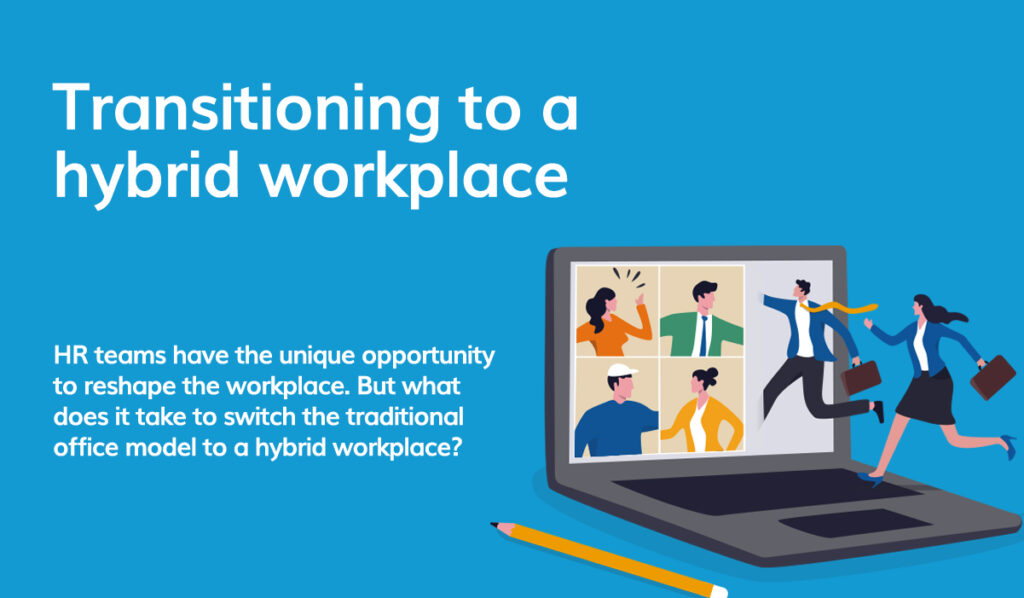In one of our recent polls respondents were clear that they expect the possibility of hybrid working to be on offer from hereon. The past year has shown us that whilst remote working and never setting foot in the office might not be conducive to team spirit at work, hybrid work offers a nice balance and ticks all the right boxes. It gives flexibility, the ability to work autonomously, supports better work-life balance, and it shows trust. These are all factors that contribute to job satisfaction and ultimately, productivity.

Reshape the workplace
But when you’re used to running office where employees are there 40 hours a week (sometimes even longer), what does it take to transition seamlessly to a hybrid working environment? Well, the first step happened without us having much say in it quite honestly. The working world fell into this modus operandi because of circumstance. Most of us were just winging it and many office cultures were flipped on their head without any rule book to follow. But now HR teams have the opportunity to take the reins back into their own hands, and to reshape the workplace according to the requirements of both the company and employees.
Change is opportunity
I say opportunity because being part of a change is always an opportunity. An opportunity to do things differently – to do things better. But whilst change can be exciting, it’s hardly ever easy. Actually, changing a system that has been in place for the past fifty years or so can be quite daunting. There will be challenges. So what does it take to transition successfully to a hybrid working model and, most importantly, to make it work?
You might find that you’re already halfway there, (special thanks goes to Covid-19):
Create a working schedule
Flexibility does not mean free-for-all, so do put some form of a working schedule in place. It might be better for certain workers to be in the office at the same time for the sake of collaboration and to have as little detachment as possible amongst the teams.
Redecorate
Safety should always come first, at least for the foreseeable future. Change your offices around to accommodate this, but be sure that once this is all behind us, the changes you make can still work for you. The space needs to be designed to support both in-person and remote workers, with any necessary technology to facilitate virtual meetings. Make the space where employees do come together as engaging and inspiring as possible; a space that cannot easily be recreated at home.
Communication
This one is key to employee engagement. In reality it always is, but in this case it is fundamental. First off, employees need to know what to expect and what is expected of them. Communicate your plan and include them in the journey of transition. Get feedback from them. Their perspective is invaluable and will definitely contribute to a successful transition.
Choose your channels
This is linked to the previous point. Because employees are not together all the time, communication might need to be planned. See that you have the right technology to support this. Whatever channels you decide to use, train employees to use them correctly and to be aware when someone is at the office, in a meeting, working from home or off.
Make it inclusive
As way of example, research has shown that the more closely you work with your manager, the more likely you are to get promoted. In a hybrid workplace this might mean that some workers never get the chance to work with their manager in person. If the company is introducing a hybrid workplace that it needs to be aware of these things. The change must not disadvantage any employees.
Check-in regularly
Hold individual meetings with employees regularly to see how they’re getting on. Are they are finding it difficult to adapt their skills to this new mode of working? Is there anything that can be tweaked to support them? The beginning will be a work in progress until the system is fine-tuned.
Finding a balance
Keep in mind that there is no ‘one-size-fits-all’ solution for this. Many companies will have to trial and test a few things to see what works for them and for their employees. In fact, the ideal balance is not an easy one to strike. For example, PWC found that 68% of executives believe that workers should be in the office at least 3 days a week to disrupt company culture as little as possible. Yet, 55% of workers preferred to work from home 3 days a week. Whatever arrangement your company decides upon, considering the culture, values and vision is the best place to start.

